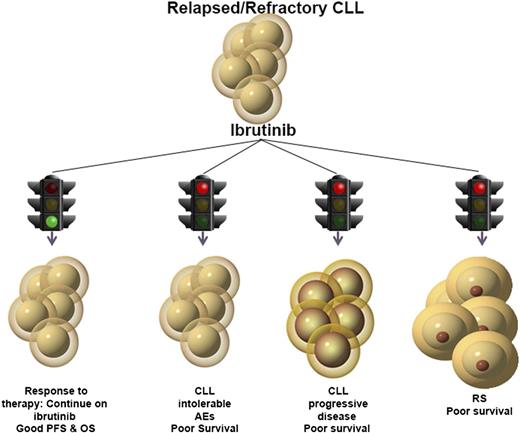In this issue of Blood, Jain et al reported on the poor outcomes of patients with chronic lymphocytic leukemia (CLL) after the discontinuation of ibrutinib.1
Possible outcomes after ibrutinib discontinuation. Patients who discontinued ibrutinib have a very poor prognosis and OS independent of the reason for discontinuation. AEs, adverse events; PFS, progression-free survival.
Possible outcomes after ibrutinib discontinuation. Patients who discontinued ibrutinib have a very poor prognosis and OS independent of the reason for discontinuation. AEs, adverse events; PFS, progression-free survival.
Targeting the B-cell receptor (BCR) pathway represents one of the most important milestones in the current treatment of chronic lymphocytic leukemia (CLL). Two compounds that inhibit the BCR pathway, ibrutinib and idelalisib, are currently available for the treatment of relapsed/refractory CLL.
Ibrutinib is an irreversible inhibitor of Bruton tyrosine kinase, an important component of the BCR signaling pathway that is essential for cell survival, adhesion, and homing.2 Ibrutinib has shown clinical efficacy, with durable remissions and a low-toxicity profile in patients with relapsed/refractory CLL, including those with 17p deletion.3 This drug has also been demonstrated to be superior to ofatumumab, with a significantly better progression-free survival and overall survival (OS) in a large phase III study.4 On the basis of these results, ibrutinib was approved by the US Food and Drug Administration for relapsed CLL and CLL with 17p deletion, changing the treatment landscape of CLL. The reported trial rates of discontinuation ranged from 18% to 36%, depending on the median follow-up; however, the detailed characteristics and outcomes of these cases are not well known.
Jain and colleagues studied the outcomes of patients who discontinued ibrutinib for several reasons in 4 different trials enrolled at MD Anderson Cancer Center.1 In this report, 33 of 127 patients discontinued ibrutinib; approximately half of these (n = 14) discontinued the drug due to progressive disease (PD). Seven patients developed Richter transformation or Richter syndrome (RS), and the remaining patients had progression of CLL without RS. Patients who had PD on ibrutinib were most likely to have 17p deletion, complex karyotype, and unmutated status of the immunoglobulin heavy chain variable region. Responding patients discontinued treatment due to adverse events (n = 11) and death (n = 3). The OS for all these patients, regardless of the reason of ibrutinib discontinuation, was extremely poor, with a median OS of 3.1 months (see figure).
There are some take-home lessons from the study by Jain et al, the foremost being the very poor prognosis and OS of CLL patients who discontinued the drug regardless of the reason. Although it is expected that PD in patients after targeted therapy could be associated with a poor prognosis, it is important to try to explain the potential reasons for the very short OS in this scenario. Such a short OS is not seen in other poor-risk CLL conditions such as RS (median OS of 8-30 months) and in fludarabine-refractory patients (median OS of 10 months).5,6 Clonal selection of aggressive CLL/RS clones already present at the time of therapy initiation could be postulated. Losses of TP53 and CDKN2A with MYC activation, as well as trisomy 12 in association with NOTCH1 mutations, were the most common alterations previously described in RS after CLL. These abnormalities were associated with a proliferative RS and an OS of <6 months.7 Intrinsic resistance to ibrutinib in CLL could also play a role by the development of mutations in the C481S position of the Bruton tyrosine kinase gene and in PLCγ2, as has been recently reported, especially in patients with progressive CLL but no RS.8,9 These events may be the reason for ibrutinib discontinuation not only in patients with progressive CLL but also in patients who stopped the drug for other reasons.
Although these assumptions are purely hypothetical and speculative, they are suggested by the increased rate of ibrutinib discontinuation seen with longer follow-up (14% and 36% discontinuation rate at a median follow-up of 9.5 and 21 months, respectively), which could represent the acquisition of new mutations over time that could lead to resistance and/or development or expansion of aggressive CLL/RS clones. Many of these questions might be answered in the near future with next-generation sequencing studies at ibrutinib therapy initiation and on discontinuation, which could add more value to the present report.
Definitely, ibrutinib has dramatically changed the landscape of relapsed/refractory CLL treatment and constitutes an important paradigm in the molecularly targeted approach of this disease, with excellent efficacy and tolerability. However, patients who discontinue treatment represent a challenge to the practicing oncologist, and treatment options are very limited. In the near future, early identification of very high-risk patients treated with ibrutinib should be the target of new combinatorial therapies that can improve the outcomes in this population. This report highlights that the road toward a cure (or effective disease control) of CLL has not ended and that, instead, we might be facing a new unmet need in this disease.
Conflict-of-interest disclosure: J.P.-I. is a consultant for and received honoraria from Janssen; J.C.C. declares no competing financial interests.



